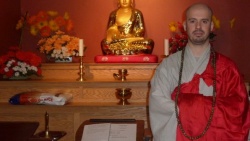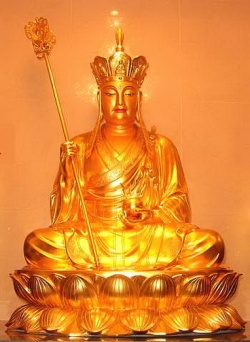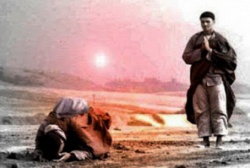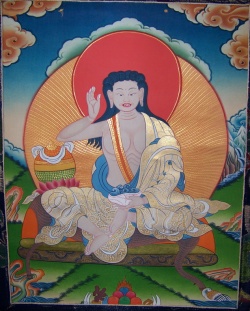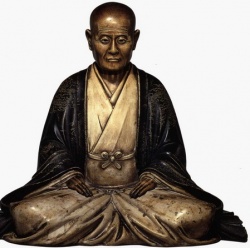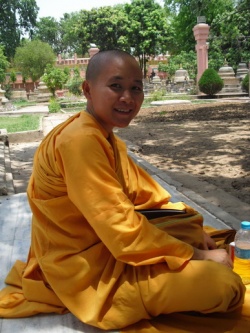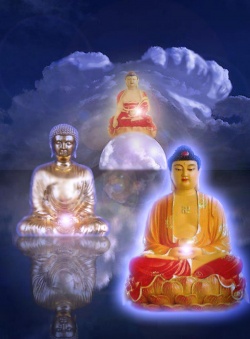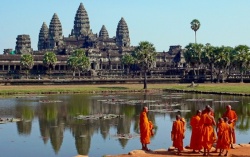Sādhanas and the Tantras
Sādhanas are only one type of tantric literature. The tantric corpus, the history of which is difficult to determine with any precision,4 includes the "root" tantras (attributed to the historical buddha), explanatory tantras,
commentaries on specific tantras, works on the general philosophy and structure of Tantra,5 sādhanas, songs(dohā, nyams mgur), and a variety of ritual texts.
However, because the sādhana contains guidelines for the actual performance of rituals, it is the type of text that has the greatest practical importance for sādhakas, those who have ritually received the permission and empowerment to practice a specific tantra.6
Tantras themselves are ill-suited to be recited as the basis of a rite: they are arranged unsystematically;
they contain deliberately obscure language; and they do not extensively describe preliminary practices typically considered essential in a sādhana, such as rousing in oneself an attitude of renouncing the cycle of rebirth, generating compassion, and ascertaining that phenomena are empty (stong pa) of inherent establishment (rang bzhin gyis grub pa).[page 333]
A useful sādhana will guide one through each phase of the preliminary and main services of the liturgy in a clear and precise fashion. Even so, it cannot stand alone.
Further oral instruction from a competent guru (bla ma) is considered crucial. Indian sādhanas, in particular, tend to be mere outlines;7 those composed in Tibet frequently are much more detailed and some are, in fact, elaborations of the Indian texts.8 Even the most elaborate sādhanas may give only a sketchy description of the environment and deities to be visualized.
One is expected to rely on oral instruction and on icons (which are created with rigorous adherence to sādhana depictions). Indeed, much Tibetan religious art depicts the deities of tantric Buddhism and is produced not merely to pay homage to deities or to inspire the pious, but to facilitate deity yoga.
From a given tantra can come countless sādhanas, dif
fering greatly in length and intricacy. The Sanskrit sense of tantras as "threads" suggests a material from which many sādhanas may be woven; similarly, the Tibetan translation, rgyud ("stream" or "continuum"), suggests a flow that can be channeled in many different ways.
The generation of new sādhanas may be attributed to factors such as the differences among lineages of explanation (as they might be embodied, for instance, in different explanatory tantras) or a teacher's decision to tailor a sādhana to the needs of specific students or to modify it in a manner that reflects his or her preferences and experience.9
Consequently, although several hundred sādhanas are contained in the Tibetan Buddhist canon—the sDe dge bsTan 'gyur alone has four sādhana collections10 comprising over 560 items—there are far more to be found in the works of indigenous Tibetan scholars and yogīs.11
One prominent non-canonical collection is the sGrub thabs kun btus ("Collection of All Sādhanas") compiled in fourteen volumes by 'Jam dbyangs blo gter dbang po; the rNying ma collections of the "old" tantras of the first dissemination of Buddhism in Tibet and of "discovered" (gter ma) texts also contain many sādhanas.12 Only a few sādhanas have been translated into Western languages.13
Each of the four principal orders of Tibetan Buddhism has placed more emphasis on certain deities than others, which in turn is reflected in the proportion of sādhanas that have been written for those deities.
For instance, Vajrakīla and Hayagrīva are particularly important for the rNying ma order, Heruka Cakrasaṃvara for the bKa' brgyud, Hevajra for the Sa skya, and Yamāntaka and Guhyasamāja for the dGe lugs.
Notes
[4] As Wayman (1987: 473) has noted, the tantric tradition probably developed orally from around the third century C.E., leaving textual evidence only by way of chapters appended to other works which are concerned with dhāraṇī, and thus with evocation of a deity by means of mantra.
Hirakawa Akira (526-527) finds evidence for a dating of the sixth or seventh century for first texts of the Kriyā, Caryā, and Yoga Tantra type (to use the fourteenth-century scholar Bu ston's classification).
It appears that the oldest extant tantra of the Anuttarayoga type is the Guhyasamāja Tantra, produced no later than the end of the eighth century.
Inasmuch as the very essence of tantra is ritual performance, sādhanas or sādhana-like texts must have have been produced[page 339] right along with root tantras.
The Indian sādhanas collected in the Sādhanamālā, the oldest extant manuscript of which is dated to 1165 C.E. (D. C. Bhattacharyya: 3), may have been composed over many centuries.
The authors to whom these sādhanas are attributed range from Saraha, the "tantric" Nāgārjuna, and Lūyipa, all of whom may have lived as early as the seventh century, to Abhayākaragupta, who flourished in the twelfth century. Many of them, however, are anonymous. Most of these short sādhanas are found in Tibetan translation in the bsTan 'gyur of the Tibetan Buddhist canon.
[5] A number of indigenous Tibetan treatises describe the general procedure for tantric practice.
For instance, Tsong kha pa's vast sNgags rim chen mo synthesizes many tantras, commentaries, and sādhanas; however, since even it makes somewhat broad generalizations, it lacks the specific, detailed visualization instructions required for practice, although it is true that some sādhanas could easily be constructed from it.
Similarly, there are also works that set forth in great detail the way to practice the stage of generation of a given tantra, but do not contain all the elements of a sādhana.
[6] One is empowered to perform a sādhana only if one has been "purified" and "enhanced" by initiation. It is also through the initiation that one really learns the sādhana, since the initiation is as much a rehearsal of the sādhana as the sādhana is a rehearsal for buddhahood.
[7]
See, for instance, the hundreds of short Indian sādhanas in the Sādhanamālā (Bhattacharya, 1968), an extra-canonical compilation that includes sādhanas from virtually the entire history of Indian Buddhist tantrism.
[8] There are sādhanas in the bsTan 'gyur of the Tibetan canon that are virtually identical to the Indian sādhanas in the Sādhanamālā. However, as Wayman (1973: 55) notes, most of the subsequent Tibetan sādhanas based on Indian originals are superior in terms of completeness.
[9] An excellent example of this among those deity yoga manuals translated into English are the three versions of the Kālacakra practice included in Dalai Lama XIV, 1985: 381-433—a simple, general practice formulated in the seventeenth century by the first Paṇ chen Lama, Blo bzang chos kyi rgyal mtshan (1567?-1662);
a much more elaborate practice formulated by the present Dalai Lama, Tenzin Gyatso, and versified by Gling Rin po che (1903-1983); and a very short practice by Blo bzang bstan 'dzin.
[10] The collections are Pa tshab sgrub thabs brgya rtsa, Ba ri sgrub thabs brgya rtsa, sGrub thabs rgya mtsho, and Lha so so sna tshogs kyi sgrub thabs.
[11]
A desideratum, but a task beyond the scope of this chapter, is a survey of all of the collected works (gsung 'bum) of major writers in each of the principal orders to determine which deities they chose for sādhana composition, how long were their works, and to what degree they depended upon Indian sādhanas.
We would expect to see numbers in proportion to the attention given those deities in the respective
traditions, but it would be interesting to see how emphases may have shifted over time. One difficulty with that task is that not all sādhanas are clearly labelled as such by title and there are a great many "branch" texts, such as short works on the stage of generation[page 340] (utpattikrama, bskyed rim) of particular deities, empowerment texts, ritual texts for fire offerings, or works on the maṇḍalas of various deities, such as the Niṣpannayogāvalī of Abhayākaragupta, that are similar to sādhanas. Thus, one would have many individual texts to examine.
For example, in the catalogue of works for authors of the dGe lugs tradition who composed a quantity of texts large enough to have "Collected Works" (the catalogue's name is gSung 'bum dkar chag), there are between 10,000 and 15,000 individual titles.
The lists of dGe lugs founder Tsong kha pa Blo bzang grags pa and his two principal disciples, rGyal tsab dar ma rin chen and mKhas grub dge legs dpal bzang, show several Guyhasamāja, Vajrabhairava (a form of Yamāntaka), and Kālacakra works and a smaller number for Cakrasaṃvara, Hevajra, and others.
Mullin (1983: 44), who has analyzed the works of the Dalai Lamas, notes that several composed dozens of sādhanas. The fifth Dalai Lama is famed for sādhanas he composed for twenty-five deities.
[12] The rNying ma scholar Tulku Thondup Rinpoche (1986) provides schema of the categories of texts in two non-canonical rNying ma collections, the rNying ma rgyud 'bum (182-183), the original collection of tantras used by the rNying ma order, and the Rin chen gter gyi mdzod (186-188), a major collection of "discovered" (gter ma) texts. Both contain many sādhanas.
[13] English translations of sādhanas can be found, inter alia, in Beyer (1973 and 1974), Mullin (1983 and 1991), Dalai Lama XIV (1985 and 1988), Willis, Willson (1984, 1985, and 1986), Yeshe, Blofeld, and Conze (1956 and 1964).
Davidson discusses a number of important Sa skya sādhanas for the Hevajra cycle, including a detailed summation of dKon mchog lhun grub's mNgon rtogs yan lag drug pa'i mdzes rgyan with elaborations from Ngor chen Kun dga' bzang po's dPal kye rdo rje'i sgrub pa'i thabs kyi rgya cher bshad pa bskyed rim gnad kyi zla zer.
The rNying ma scholar Tulku Thondup Rinpoche (1986: 177-181) summarizes Rig 'dzin 'dus pa, a model sādhana of the kLong chen snying thig cycle discovered by 'Jigs med gling pa (1729-1798).
In an earlier work (1982) he translated the same author's rNam mkhyen lam bzang, called a "preliminary" (sngon 'gro), but really, as he notes, a complete sādhana.
